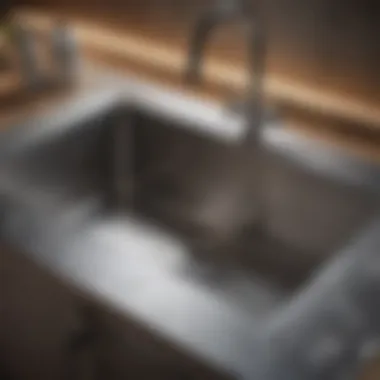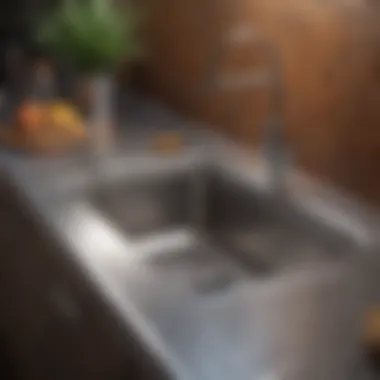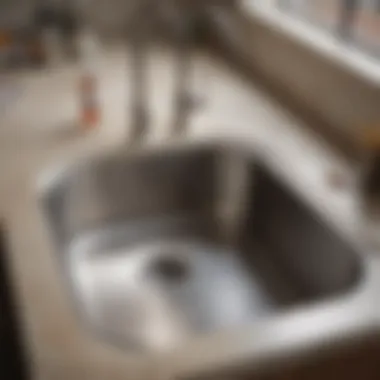Best Practices for Cleaning a Stainless Steel Sink


Intro
Maintaining the appearance of a stainless steel sink is vital for both aesthetic and functional purposes. Stainless steel has gained popularity in kitchens due to its modern look, durability, and resistance to rust and stains. However, it is not immune to scratches and tarnishes, if not cared for properly. This article will present you with best practices for cleaning and maintaining stainless steel sinks, enabling you to keep your sink looking pristine over time.
Understanding the characteristics of stainless steel is essential in choosing the right cleaning methods. Unlike other materials, this alloy can exhibit fingerprints, water spots, and stains from food substances and minerals. Therefore, knowing which cleaning products and techniques to use will play a significant role in preserving the sink’s condition and enhancing its lifespan.
You will encounter various cleaning options, from natural solutions that can be easily made at home to chemical cleaners designed for specific stains. Additionally, we will address common concerns such as maintaining shine, removing odors, and preventing scratches. Each section aims to provide deeper knowledge and practical advice tailored to homeowners and design enthusiasts alike.
Understanding Stainless Steel Sinks
Understanding stainless steel sinks is essential for anyone looking to maintain and care for their kitchen fixtures effectively. Stainless steel is a popular material due to its unique properties and aesthetic appeal. This section will cover the material composition, common features, and various benefits associated with stainless steel sinks, providing a comprehensive foundation for good cleaning practices.
Material Composition
Stainless steel sinks are primarily made of an alloy that contains iron, chromium, and nickel. The chromium content provides corrosion resistance, while nickel enhances the material's durability and shine. Most kitchen sinks are made from 304 or 316 grade stainless steel. The 304 grade is the most commonly used due to its excellent resistance to rust and staining. In contrast, the 316 grade is superior for environments where corrosion is a concern, such as near saltwater or harsh chemicals. Understanding these compositions helps in choosing the right sink for your specific needs, impacting both function and maintenance.
Common Features
Stainless steel sinks come with various features that enhance their utility. Most have a sleek and modern appearance, adding to the overall design of the kitchen. They can have different finishes, such as brushed or polished, which affect both aesthetics and cleaning ease. Another common feature is sound-deadening insulation, which minimizes noise from pots and dishes. Additionally, many sinks include multiple basins for increased versatility, enabling users to separate washing and rinsing tasks efficiently.
Benefits of Stainless Steel Sinks
The benefits of stainless steel sinks are numerous. Due to their resilience, they can withstand heavy use and are less likely to dent or chip compared to other material types. Their shiny surface does not absorb odors or bacteria, making it a hygienic choice for food preparation. Stainless steel also has a timeless appeal, fitting in both modern and traditional kitchens. Furthermore, they are relatively easy to clean and maintain, making them a practical option for homeowners.
In summary, the understanding of stainless steel sinks involves appreciating their materials, features, and advantages. Such knowledge lays the groundwork for effective cleaning and maintenance practices, essential for prolonging the sink's life and enhancing its performance.
Importance of Cleaning Your Stainless Steel Sink
Keeping a stainless steel sink clean is much more than a matter of aesthetics. The ongoing maintenance and care of your sink directly relate to health, longevity, and visual appeal. By understanding these aspects, homeowners can enhance the functionality and appearance of their kitchens.
Health Considerations
A clean sink is vital for overall kitchen hygiene. Stainless steel has properties that resist bacterial growth, yet neglect can lead to build-up of germs and bacteria. Food particles and residues can become breeding grounds for pathogens, potentially leading to foodborne illnesses. Regular cleaning eliminates these risks.
In households, especially where food preparation happens, attention to hygiene is crucial. Utilizing appropriate cleaners ensures that harmful microbes are effectively managed. Furthermore, it’s important to disinfect surfaces periodically to maintain not just cleanliness, but a safer cooking environment. This underscores the necessity of an efficient cleaning routine.
Preventing Damage
Stainless steel sinks are durable. However, improper cleaning methods can cause scratches and dullness over time. Using harsh or abrasive cleaners may strip the protective layer of the steel, leading to corrosion. Understandably, this deterioration not only impacts functionality but also incurs additional expenses on repairs or replacement.
It is essential to incorporate proper cleaning techniques. For example, avoiding steel wool pads and opting for soft cloths will help preserve the sink's surface. Regular care shields the material from potential damage, ensuring that the sink remains a functional centerpiece in your kitchen without requiring costly interventions.
Aesthetic Value
The appearance of a stainless steel sink plays a significant role in the kitchen’s overall design. A clean sink contributes to the overall ambiance, reflecting a sense of order and care in the home. When surfaces shine, they uplift the environment and may influence the perception of cleanliness throughout the kitchen.
A stained or tarnished sink detracts from even the most meticulously crafted kitchens. Maintaining its appearance ensures that the sink harmonizes with the kitchen decor. Regular cleaning on a daily and deeper scale helps in achieving and sustaining that polished look.
A clean and well-maintained stainless steel sink contributes positively to overall kitchen hygiene, aesthetic appeal, and surface longevity.
In summary, cleaning your stainless steel sink is a fundamental practice for homeowners. Addressing health considerations, preventing damage, and enhancing aesthetic value are vital in achieving a well-functioning kitchen environment.
Daily Cleaning Routine
Maintaining a regular cleaning schedule for your stainless steel sink is essential. This practice not only preserves its shine but also wards off grime and unsightly stains. A clean sink creates a more hygienic environment for food preparation and enhances the overall aesthetics of your kitchen.
Basic Cleaning Supplies
To ensure an effective daily cleaning routine, you need a few essential supplies. The basic items for maintaining your stainless steel sink include:


- Mild dish soap: Choose a gentle dish soap that can cut through grease without damaging the finish.
- Soft sponge or cloth: Abrasive materials can scratch the surface. A non-scratch sponge is ideal.
- Microfiber cloth: This can be used for drying and buffing the sink for a streak-free shine.
- Baking soda: A mild abrasive that can tackle tough spots without causing scratches.
- White vinegar: This natural cleaner is effective against hard water stains and can help maintain shine.
Quick Wipe Down Instructions
A quick wipe down can be incorporated into your daily routine with minimal effort. Follow these simple steps:
- Rinse the sink with warm water to remove any loose debris or food particles.
- Apply a few drops of mild dish soap onto the sponge.
- Wipe the entire sink surface using circular motions. Pay special attention to corners and the drain area.
- Rinse the sponge and wipe the sink again to remove all soapy residue.
- To finish, rinse the sink with warm water, then dry it with a microfiber cloth to prevent water spots.
Dealing with Residue
Residue can accumulate in corners and edges if not addressed promptly. For persistent residue:
- Use baking soda: Sprinkle a light layer of baking soda over the affected area, then scrub gently with a soft sponge.
- Rinse thoroughly: Ensure no baking soda remains, as it can lead to a dull appearance.
- Consider vinegar: If stains persist, spray a mixture of equal parts vinegar and water onto the area. Let it sit for a few minutes before wiping down again.
By adhering to these practices, you can keep your stainless steel sink looking pristine. Regular upkeep reduces the need for more intensive cleaning later, making your kitchen maintenance efficient and hassle-free.
"A clean sink reflects care in the kitchen, influencing hygiene and aesthetic appeal."
Deep Cleaning Methods
Deep cleaning is essential for maintaining the integrity and appearance of a stainless steel sink. Unlike quick daily wipes, deep cleaning involves more thorough techniques that tackle the buildup of grime, stains, and hard-to-reach areas. This process can revive the shine of the sink and prolong its lifespan. Understanding how to properly deep clean a stainless steel sink is crucial for homeowners who aim for a hygienic and aesthetically pleasing kitchen space.
Choosing the Right Cleaners
Selecting the right cleaner can significantly influence the effectiveness of your deep cleaning efforts. It's important to understand the different categories of cleaners available, each with distinct properties.
Acidic Cleaners
Acidic cleaners are known for their power to break down mineral deposits like limescale. Their capability to cut through tough grime makes them a popular choice for deep cleaning stainless steel sinks.
One key characteristic of acidic cleaners is that they can effectively dissolves stubborn stains. For instance, products containing citric acid or vinegar are often recommended. However, while they are effective, using excessive amounts can lead to the dulling of the sink’s surface over time. It is advisable to use them cautiously and always rinse thoroughly after application.
Abrasive Cleaners
Abrasive cleaners can be effective for removing heavy stains and scratches on stainless steel. These cleaners contain fine particles that help scrub away residues. A key feature of abrasive cleaners is their texture, which provides a powerful scrubbing action.
The advantage of these cleaners is their efficacy against tough stains, but there is also a risk. If used improperly, they can scratch the metal surface, which creates spots that may rust. Therefore, it's essential to use these cleaners sparingly and follow the manufacturer's guidelines to prevent damage.
Natural Cleaners
Natural cleaners offer an eco-friendly alternative for those looking to avoid harsh chemicals. Ingredients like baking soda, lemon juice, and olive oil are known for their cleaning properties. One significant characteristic of natural cleaners is their safety for both the environment and the users.
Natural solutions are often sought after due to their effectiveness against regular grime while being gentle on the metal surface. However, they may not always handle heavier stains compared to chemical options. Using a combination of natural cleaners can deliver adequate results for maintenance without risking harm to the equipment or environment.
Step-by-Step Deep Cleaning Process
- Preparation: Gather Materials
Collect the chosen cleaners, soft cloths, sponges, and brushes suitable for steel sinks. - Initial Rinse:
Rinse the sink with hot water to remove surface debris. - Apply Cleaner:
Choose the appropriate cleaner based on the stain type. Apply it generously, allowing it to sit for a few minutes. - Scrub Gently:
Use a soft cloth or non-abrasive sponge to scrub. For tough spots, a soft-bristled brush can work well. - Rinse Thoroughly:
Wash away the cleaner with warm water, ensuring no residue is left behind. - Dry the Sink:
Use a microfiber cloth to wipe down the sink to prevent water spots.
Rinsing and Drying Techniques
Rinsing is an important aspect of the cleaning process. It's crucial to remove all cleaning agents to prevent any possible reaction with food or residue. Always rinse with warm water as this helps to remove cleaner residues effectively.
After rinsing, drying the sink is essential to maintaining its shine. Using a microfiber cloth encourages a polished look while preventing streaks. For optimal results, dry after each use, especially if you notice hard water buildup.
Remember that regular deep cleaning can maximize the lifespan of your stainless steel sink and maintain its aesthetic appeal.
Addressing Stains and Scratches
Addressing stains and scratches in a stainless steel sink is essential for both its appearance and longevity. Stainless steel sinks are known for their durability, but they are not immune to everyday wear and tear. Regular attention to stains and scratches can prevent more serious damage, ensuring that the sink maintains its sleek look and functionality over time. A well-maintained sink is not just a visual asset; it also contributes to a healthier kitchen environment.


Identifying Common Stains
Stains on stainless steel can occur from various sources, and identifying them is the first step towards effective cleaning.
- Water spots: These are common in homes with hard water. They result from mineral deposits left behind after the water evaporates.
- Food stains: Certain foods, especially acidic ones like tomatoes, can leave marks on the sink surface.
- Coffee and tea stains: These beverages can leave brownish stains that are often tough to remove.
- Rust: Sometimes, metal objects left in the sink can start to rust, creating reddish stains.
By understanding the type of stains present, homeowners can choose appropriate cleaning solutions.
Recommended Solutions for Stains
Once stains have been identified, the next step is to select the right cleaning solution. Each type of stain may require a different approach:
- For water spots:
- For food stains:
- For coffee and tea stains:
- For rust stains:
- White vinegar can be effective. Apply it directly to the affected area, let it sit for a few minutes, then wipe with a soft cloth.
- A mixture of baking soda and water can also be used as a gentle abrasive.
- A mild dish soap diluted with water can work. Use a soft sponge and rub gently.
- For tougher stains, a non-abrasive cleaner such as Bar Keepers Friend can help.
- Try a paste made from baking soda and water. Let it sit for several minutes before scrubbing gently.
- Use a rust remover specifically designed for stainless steel, following the manufacturer's instructions carefully to avoid further damage.
Repairing Scratches
Scratches are another common issue for stainless steel sinks. While some scratches are surface-level and can be polished out, deeper scratches may require more careful attention.
- For minor scratches:
- For deeper scratches:
- Consulting professionals: If scratches are extensive or if the sink has a brushed finish, it may be wise to consult professional services for refinishing. They can restore the sink to its original state.
- Use a non-abrasive pad along with a stainless steel cleaner. Rub in the direction of the grain to reduce visibility.
- Consider using a fine grit sandpaper or a steel wool pad. Lightly sand the area, again following the grain direction. It is essential to be gentle to avoid further damage.
By understanding how to identify and treat stains and scratches effectively, homeowners can not only enhance the aesthetic appeal of their stainless steel sinks but also prolong their service life.
Maintenance Tips for Longevity
Maintaining a stainless steel sink is essential for prolonging its life and ensuring it remains functional and visually appealing. Stainless steel is known for its durability, but neglect can lead to scratches, stains, and tarnishing. Understanding best practices is crucial for any homeowner or kitchen enthusiast who wants to preserve the beauty and integrity of their sink over time. Regular maintenance not only enhances hygiene but also protects the investment made in kitchen fixtures.
Regular Maintenance Schedule
A well-established cleaning routine is fundamental to maintaining a stainless steel sink. Setting a regular maintenance schedule can help keep the sink in top condition. Aim for a quick daily wipe down using a soft cloth and mild dish soap to prevent the buildup of grime and water spots. On a weekly basis, consider a more thorough cleaning using a dedicated stainless steel cleaner. This will help remove any accumulated residues and restore shine.
It helps to use a calendar or reminders on your smartphone to ensure these tasks are not overlooked. For those who are busy or tend to forget schedules, this is an effective way to incorporate sink cleaning into the broader cleaning regimen of the kitchen.
Best Practices for Preventing Damage
Being proactive is of utmost importance when it comes to preventing damage to stainless steel sinks. Always use soft cloths or sponges for cleaning. Avoid abrasive materials like steel wool which can scratch the surface. When using chemicals, choose ones specifically formulated for stainless steel to avoid corrosion.
Additionally, avoid letting acidic substances such as vinegar, lemon juice, or harsh cleaners sit in the sink for extended periods. Prompt rinsing after each use goes a long way in preventing discoloration and pitting. To protect the sink from physical damage, use cutting boards and pads when working with utensils.
Choosing Protective Products
Choosing the right cleaning and protective products plays a significant role in maintaining your stainless steel sink. Look for products designed specifically for stainless steel. These are often labeled as non-abrasive and include ingredients that help to eliminate stains without risking damage to the finish.
When selecting a product, consider the following:
- Read labels carefully: Ensure products do not contain bleach or mineral acids.
- Test small areas: Before applying new products, test them on a less visible section of the sink.
- Natural options: Some homeowners prefer eco-friendly solutions such as baking soda and vinegar. These can effectively clean and disinfect without harsh chemicals.
By consciously following these maintenance tips, you will significantly extend the life and appearance of your stainless steel sink.


Eco-Friendly Cleaning Alternatives
In recent years, the move toward sustainable living has gained momentum. This perspective includes cleaning products. Using eco-friendly cleaning alternatives helps to lessen the impact on the environment while maintaining the quality of your stainless steel sink. These alternatives often minimize exposure to harmful chemicals in traditional cleaners. Furthermore, many homemade solutions are just as effective as store-bought products. Making this choice can contribute to a healthier home environment and reduce waste.
Homemade Cleaning Solutions
Homemade cleaning solutions for stainless steel sinks can be both effective and cost-efficient. Ingredients commonly found in most homes can be used, reducing the need to buy separate cleaning products. Some popular options include:
- Baking Soda: This is a versatile cleaning agent. When mixed with a little water to form a paste, it can tackle tough stains and grime without causing scratches.
- Vinegar: A natural disinfectant, vinegar can eliminate bacteria. When diluted with water, it enhances shine on stainless steel surfaces.
- Lemon Juice: The acidity of lemon juice acts as a natural stain remover and freshener. Its pleasant scent is an added benefit.
When using these solutions, apply with a soft cloth and rinse thoroughly to avoid residue. This can keep your sink shiny and clean without harsh chemicals.
Product Recommendations
For those who prefer ready-made products but still want to stay green, there are several eco-friendly cleaners available. Look for products labeled as biodegradable or free from phosphates and chlorine. Brands such as Seventh Generation and Method offer effective options. These cleaners are designed to be tough on dirt while being gentle on your environment.
When choosing a cleaner, check the ingredient list. Opt for products that use plant-based ingredients. Many eco-friendly cleaners are also certified by third-party organizations, which can give you confidence in their safety and effectiveness.
Evaluating Effectiveness of Eco-Friendly Cleaners
To assess the effectiveness of eco-friendly cleaners, consider several factors. First, test the product on a small area of your sink to ensure it does not cause any damage. Observe how well it lifts stains and cleans surfaces. It is also essential to evaluate the product's scent and feel when finished.
Feedback from other users can also provide valuable insight. Look for reviews online, maybe on platforms like Reddit or home improvement forums. Understanding how others have used these products can help inform your purchase decisions.
"Using eco-friendly cleaners not only benefits your health but also supports sustainable practices and reduces environmental impact."
In summary, eco-friendly cleaning alternatives pave the way for a cleaner sink and a healthier planet. When homeowners utilize these solutions, they contribute to a reduction in chemical usage and waste, while still achieving a high standard of cleanliness in their kitchens.
Shopping for Cleaning Supplies
Choosing the right cleaning supplies is crucial for maintaining the luster and functionality of a stainless steel sink. An informed selection not only simplifies cleaning tasks but also contributes to the longevity of the sink. Different cleaners have varying effects on the surface. Therefore, understanding what to look for when shopping can greatly enhance your cleaning routine.
What to Look for in Cleaners
When selecting a cleaner, there are some key factors to consider:
- Compatibility: Ensure the cleaner is safe for stainless steel surfaces. Many products contain harsh chemicals that can cause damage or lead to tarnishing.
- Effectiveness: Look for cleaners that can tackle tough stains, grease, and water spots without excessive scrubbing. Reading product reviews can provide insights into a cleaner's performance.
- Ease of Use: Some cleaners come in spray form, while others are liquids or powders. The choice often depends on personal preference and the specific cleaning needs of your sink.
- Environmental Impact: If sustainability is important to you, consider eco-friendly options that utilize natural ingredients.
Avoiding Harmful Chemicals
Avoiding harmful chemicals is essential, not only for the longevity of your sink but also for health considerations. Harsh chemicals can lead to physical and environmental harm. Here’s why:
- Health Risks: Some commercial cleaners contain toxins that can irritate skin or respiratory systems. Opting for safer alternatives is a wise choice.
- Surface Damage: Chemicals such as bleach or hydrochloric acid can corrode the stainless steel finish. To prevent scratching and dulling, always choose a cleaner specifically designed for stainless steel.
- Pet and Child Safety: If there are children or pets in your home, choosing non-toxic options minimizes risks associated with accidental ingestions or skin contact.
In case you encounter a stubborn stain, consider gentle methods first. Utilizing baking soda and vinegar is one example that can effectively lift stains without compromising the surface.
Price Considerations
Price can influence your choice of cleaning supplies, but it should not be the only determinant. Consider the following points:
- Quality Over Price: Often, a higher price correlates with better quality. Investing in a reliable cleaner might save you money in the long run by reducing the frequency of purchases.
- Bulk Buying: Consider purchasing in bulk, especially for commonly used cleaners. This approach can offer significant savings over time.
- Assessing Value: Some cheaper options may be less effective, leading to more frequent use, which nullifies their low price advantage.
Epilogue
In this article, we explored the critical aspects of maintaining a stainless steel sink, emphasizing the necessity of proper cleaning techniques and practices. Stainless steel sinks offer both durability and aesthetic appeal, making them a common choice in many kitchens. However, without regular care, they can become unsightly and harbor harmful bacteria. Thus, understanding how to clean this material effectively is vital for both health and longevity.
The cleaning methods discussed throughout this article highlight several key points that are essential for every homeowner, interior design enthusiast, or party host. First, using the right products can prevent damage to the surface while ensuring a thorough clean. By selecting appropriate cleaners that either chemical-based or eco-friendly, individuals can maintain the shiny appearance of their sinks.
Second, regular maintenance routines are not only beneficial but necessary. Implementing daily and weekly cleaning habits ensures that stains and scratches are kept at bay. When it comes to deeper cleans, knowing the correct procedures will help preserve the sink’s finish over time.
Finally, the solutions for addressing common stains and scratches offer further insight into the practicality of caring for stainless steel sinks. Homeowners can feel empowered to tackle these issues with a variety of recommended methods that suit their needs.
"Proper care of your stainless steel sink is not only about aesthetics; it’s also about enhancing your kitchen's hygiene and functionality."
Summarizing, the importance of regularly cleaning and maintaining stainless steel sinks cannot be overstated. Such practices resonate well beyond the surface, contributing to a healthier, cleaner home environment.



